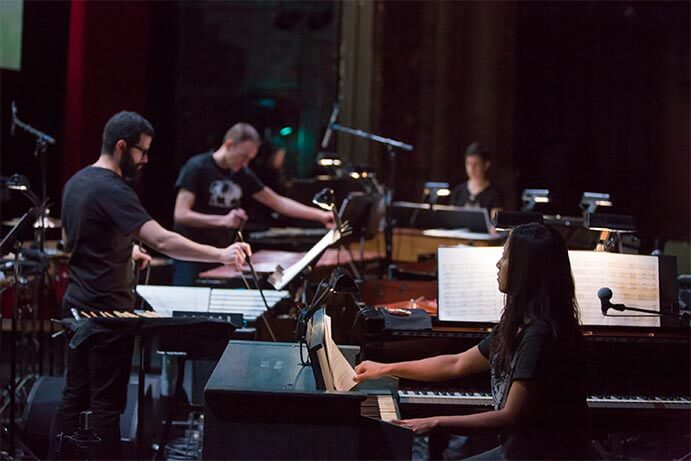Currents Vol. 0 is everything a retrospective of an early collaborative project should be, and anyone with reservations about its prequel status can safely put their doubts aside. The self-released Vol. 0 contains three pieces that predate the four albums in the original Yarn/Wire/Currents series (titled separately, Vol.1-4). The series began with the release of Vol. 1 in 2013, and has become a yearly project to perform and record experimental music. Each successive year has produced the next album in the series.
Yarn/Wire began as a student ensemble at SUNY Stony Brook in 2005, and became affiliated with ISSUE Project Room in 2012. Its current personnel (Ian Antonio and Russell Greenberg, percussion; Laura Barger and Ning Yu, pianos) are regular artist residents at ISSUE Project Room, which inspired the Yarn/Wire/Currents series. The group actively seeks composers and performers to “explore the intersections of composition, technology, installation, music theater, [and] live performance.” They have also worked with artists such as Pete Swanson, Tristan Perich, and Two-Headed Calf, and have received critical reviews for their performances at the Lincoln Center festival.
Yarn/Wire bills itself as a piano and percussion quartet, but that’s the limit of their conventional description. Many of the percussion instruments are fabricated (i.e., not traditional) as you can see in some of the group’s video recordings. Describing the percussionists as “playing a Lazy Susan” is as strange to explain as it is to see and hear. Other elements of fabricated instruments include folded up papers and ceramic cups. The effect is of a mosaic, blending individual sounds of traditional and fabricated instruments with electronics. No label other than experimental can adequately describe their work.

Tyondai Braxton‘s Music for ensemble and pitch shifter/delay (2013) begins with a driving piano pulse in rapid descending scales and shifting dynamics, then intensifies by adding other voices to the mix. Music for ensemble relies on repeating short cells of material many times with small changes arising in the relationships among the parts, but those parts are distributed among many different instruments. The pitch shifter fits well among its acoustic counterparts—its role is one of influence on the other instruments more than having its own voice. As the piece progresses and more voices play simultaneously, a more cohesive ensemble sound comes together and it becomes easier for the listener to focus on hearing individual parts or the ensemble as a whole, as he or she wishes. Staggered entrances of different instruments help to create forward momentum throughout the entire work without creating tension, a balance that Braxton skillfully maintains.
Nathan Davis‘ de clocher á clocher (2012) takes its title from a quote from Arthur Rimbaud’s Illuminations: “I have stretched ropes from bell tower to bell tower; garlands from window to window; chains of gold from start to star, and I dance.” The “bell tower to bell tower” of the title describes the opening bell tone effects in this subdued, meditative piece. Many of the tones are allowed to decay completely after sounding, creating a semi-aleatoric change of dynamics and tonal patterns. Davis is committed to preserving the organic nature of the sound of each instrument throughout the piece, which the organic decays help to variate. After the initial long tones and atmospheric layering follows, “and I dance.” Davis alternates between rhythmically dramatic cells and echoes of notes’ final resonances. While not strictly tonal, the pitched instruments (pianos, keyboards, some drums) aren’t married to any specific key; the non-pitched percussion (traditional and fabricated) blur any suggestion of tonal definition beyond that. The timbres of the pianos’ different registers become a separate effect from their pitches—the specific pitches seem auxiliary.

Peter Evans’ returns (2013) is easily the most raucous of the works included on this album. The beginning is angular, disjointed, and full of abrupt starts and indeterminate silences. The sound cells eventually grow into a cohesive body, settling at length into a groove that is both hip and completely organic. This is the closest callout to jazz of anything offered on the album. As in Braxton’s Music for ensemble, development through the additive property creates most of the momentum in this work. It would be easy, were the music in less capable hands, for the music to become frenetic and difficult to control. Neither is the case.
As a retrospective album, Currents Vol. 0 has a perfect role in the Yarn/Wire/Currents series. It combines the ensemble’s earlier compositions with the artistic maturity the members have cultivated through the four regular albums. The intersection of minimalist processes with much larger and diverse resources (traditional and otherwise) creates a musical space that is at once familiar and intimate, yet cosmopolitan and unsentimental. I’ll be following them closely to see what their next residency produces.
























